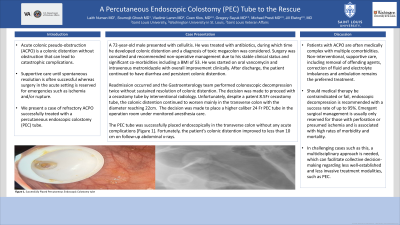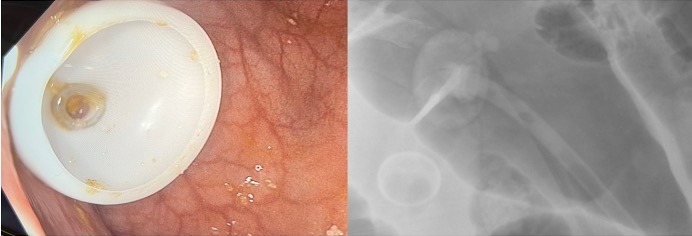Back


Poster Session E - Tuesday Afternoon
Category: Colon
E0128 - A Percutaneous Endoscopic Colostomy (PEC) Tube to the Rescue
Tuesday, October 25, 2022
3:00 PM – 5:00 PM ET
Location: Crown Ballroom

Has Audio

Laith Numan, MD
Saint Louis University
St. Louis, MO
Presenting Author(s)
Award: Presidential Poster Award
Laith Numan, MD1, Soumojit Ghosh, MD1, Vladimir Lamm, MD2, Coen L. Klos, MD3, Gregory Sayuk, MD4, Michael Presti, MD5, Jill E. Elwing, MD4
1Saint Louis University, St. Louis, MO; 2Washington University in St. Louis School of Medicine, St. Louis, MO; 3Washington University in St. Louis, St. Louis, MO; 4St. Louis VA, Washington University, St. Louis, MO; 5St. Louis VA, Saint Louis University, St. Louis, MO
Introduction: Acute colonic pseudo-obstruction (ACPO) is a colonic distention without obstruction that can lead to catastrophic complications. Supportive care until spontaneous resolution is often successful whereas surgery in the acute setting is reserved for emergencies such as ischemia and/or rupture. We present a case of refractory ACPO successfully treated with a percutaneous endoscopic colostomy (PEC) tube.
Case Description/Methods: A 72-year-old male presented with cellulitis. He was treated with antibiotics, during which time he developed colonic distention and a diagnosis of toxic megacolon was considered. Surgery was consulted and recommended non-operative management due to his stable clinical status and significant co-morbidities including a BMI of 53. He was started on oral vancomycin and intravenous metronidazole with overall improvement clinically. After discharge, the patient continued to have diarrhea and persistent colonic distention. Readmission occurred and the Gastroenterology team performed colonoscopic decompression twice without sustained resolution of colonic distention. The decision was made to proceed with a cecostomy tube by interventional radiology. Unfortunately, despite a patent 8.5Fr cecostomy tube, the colonic distention continued to worsen mainly in the transverse colon with the diameter reaching 22cm. The decision was made to place a higher caliber 24 Fr PEC tube in the operation room under monitored anesthesia care. The PEC tube was successfully placed endoscopically in the transverse colon without any acute complications [Figure-1]. Fortunately, the patient’s colonic distention improved to less than 10 cm on follow-up abdominal x-rays.
Discussion: Patients with ACPO are often medically complex with multiple comorbidities. Non-interventional, supportive care, including removal of offending agents, correction of fluid and electrolyte imbalances and ambulation remains the preferred treatment. Should medical therapy be contraindicated or fail, endoscopic decompression is recommended with a success rate of up to 95%. Emergent surgical management is usually only reserved for those with perforation or presumed ischemia and is associated with high rates of morbidity and mortality. In challenging cases such as this, a multidisciplinary approach is needed, which can facilitate collective decision-making regarding less well-established and less invasive treatment modalities, such as PEC.

Disclosures:
Laith Numan, MD1, Soumojit Ghosh, MD1, Vladimir Lamm, MD2, Coen L. Klos, MD3, Gregory Sayuk, MD4, Michael Presti, MD5, Jill E. Elwing, MD4. E0128 - A Percutaneous Endoscopic Colostomy (PEC) Tube to the Rescue, ACG 2022 Annual Scientific Meeting Abstracts. Charlotte, NC: American College of Gastroenterology.
Laith Numan, MD1, Soumojit Ghosh, MD1, Vladimir Lamm, MD2, Coen L. Klos, MD3, Gregory Sayuk, MD4, Michael Presti, MD5, Jill E. Elwing, MD4
1Saint Louis University, St. Louis, MO; 2Washington University in St. Louis School of Medicine, St. Louis, MO; 3Washington University in St. Louis, St. Louis, MO; 4St. Louis VA, Washington University, St. Louis, MO; 5St. Louis VA, Saint Louis University, St. Louis, MO
Introduction: Acute colonic pseudo-obstruction (ACPO) is a colonic distention without obstruction that can lead to catastrophic complications. Supportive care until spontaneous resolution is often successful whereas surgery in the acute setting is reserved for emergencies such as ischemia and/or rupture. We present a case of refractory ACPO successfully treated with a percutaneous endoscopic colostomy (PEC) tube.
Case Description/Methods: A 72-year-old male presented with cellulitis. He was treated with antibiotics, during which time he developed colonic distention and a diagnosis of toxic megacolon was considered. Surgery was consulted and recommended non-operative management due to his stable clinical status and significant co-morbidities including a BMI of 53. He was started on oral vancomycin and intravenous metronidazole with overall improvement clinically. After discharge, the patient continued to have diarrhea and persistent colonic distention. Readmission occurred and the Gastroenterology team performed colonoscopic decompression twice without sustained resolution of colonic distention. The decision was made to proceed with a cecostomy tube by interventional radiology. Unfortunately, despite a patent 8.5Fr cecostomy tube, the colonic distention continued to worsen mainly in the transverse colon with the diameter reaching 22cm. The decision was made to place a higher caliber 24 Fr PEC tube in the operation room under monitored anesthesia care. The PEC tube was successfully placed endoscopically in the transverse colon without any acute complications [Figure-1]. Fortunately, the patient’s colonic distention improved to less than 10 cm on follow-up abdominal x-rays.
Discussion: Patients with ACPO are often medically complex with multiple comorbidities. Non-interventional, supportive care, including removal of offending agents, correction of fluid and electrolyte imbalances and ambulation remains the preferred treatment. Should medical therapy be contraindicated or fail, endoscopic decompression is recommended with a success rate of up to 95%. Emergent surgical management is usually only reserved for those with perforation or presumed ischemia and is associated with high rates of morbidity and mortality. In challenging cases such as this, a multidisciplinary approach is needed, which can facilitate collective decision-making regarding less well-established and less invasive treatment modalities, such as PEC.

Figure: Percutaneous Endoscopic Colostomy tube in the transverse colon.
Disclosures:
Laith Numan indicated no relevant financial relationships.
Soumojit Ghosh indicated no relevant financial relationships.
Vladimir Lamm indicated no relevant financial relationships.
Coen Klos indicated no relevant financial relationships.
Gregory Sayuk indicated no relevant financial relationships.
Michael Presti indicated no relevant financial relationships.
Jill Elwing indicated no relevant financial relationships.
Laith Numan, MD1, Soumojit Ghosh, MD1, Vladimir Lamm, MD2, Coen L. Klos, MD3, Gregory Sayuk, MD4, Michael Presti, MD5, Jill E. Elwing, MD4. E0128 - A Percutaneous Endoscopic Colostomy (PEC) Tube to the Rescue, ACG 2022 Annual Scientific Meeting Abstracts. Charlotte, NC: American College of Gastroenterology.


